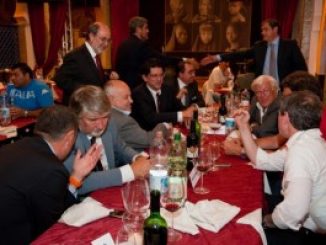
gypsies


Where the salt water meets the fresh: les Saintes Maries de la Mer
More on popular celebrations: in may, in the village of french midi les Saintes-Maries-de-la-Mer (Camargue), an extraordinary strange celebration takes place, and gypsies have an important part in it. Together with the procession for the two “canonical” saints, Saint Salomé and Saint Jacobé, gypsies from all France and other parts of Europe gather for the procession of Santa Sara, Sara Kali, or Sara the black: who officially is only the servant to the other two saints, but that the gypsies promoted as their patron saint, and that they carry into the sea. This celebration was invented in the end of the XIX century to promote turism and save a depressed region from the effects of massive migration; today it is a strange festival “in disguise”, during which both gypsies, turists and camarguaises fully entered some kind of role play, with neither shame nor complexes. For three days, gypsies with high-class caravans draw their alliances and organize marriages, and settle just opposite to the folkloric carriages that the locals organize for turists. Everybody adopts for three days the identity that the others project on them, as they are all playing, just for partying, for singing and dancing regardless of their traditions and their original musical styles. Flamenco mixes with other musics, as the gypsies with non-gypsies, just like the fresh waters of river Rhone meet the salt water of the sea, and aigues mortes of Camargue melt into the live waters of the Mediterranean.
- Marc Bordigoni (2002-3), “Le ‘pèlerinage des gitans’, entre foi, tradition et tourisme” Ethnologie française, 2002/3, vol.32, pp. 489-501.
- Among the most assiduous invitees of Santa Sara’s celebration there is the romanés band Urs Karpats, here live in 2010, known also as Ursarii, or bear tamers
- Great video about the celebration and Santa Sara, with music by Urs Karpaz: TSIGHINDIA SARA KALI :: see also Kali Sara by Latcho Drom
- Sara Kali, i.e. Sarah the Black, is not recognized as saint by any official church; the fact that her statue wears clothes is a sign of popular religion – it is the devotion of the gypsies with canonizes her as holy. Actually her statue wears many dresses one upon the other, as to symbolize the extreme devotion of her devotees. Many connect her faith with indian goddess Kali, that is also dumped underwater in an annual celebration under the form of Durga.
[audio: http://periferiesurbanes.org/wp-content/uploads/2013/01/6Rumba-gitana.mp3] Rumba gitana in Santes Maries de la Mer, recorded by ethnomusicologist Roberto Leydi in 1968…

More “rrom” evictions in Rome
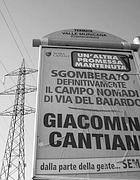 Following the policies of the previous left-wing administration, Rome's right-wing city council is executing a series of fast and almost illegal evictions against the few rrom settlements still resisting within the city (see Amnesty International declaration on 9/28/2012 eviction in Tor de' Cenci). The pretext are the alleged "problems to circulation" and the need for "urban decency", in a city in which the inauguration of a store can paralyze traffic for a whole evening, and where the parties ruling the city council break the norms on the use of public spaces. The residents of the settlements, some of which have been living more than 15 years in Rome, are forced to move to the extreme periphery, in isolated "solidarity villages" under a strict surveillance: often they resist actively to deportations. These intervention inevitably summon back the memory of the policies towards the popular neighborhoods in Rome's center during Fascism (1921-1945): the residents considered less valuable were evicted towards the suburbs, and forced to live in borgate neighborhoods, poorly built and cut off from the town.
Following the policies of the previous left-wing administration, Rome's right-wing city council is executing a series of fast and almost illegal evictions against the few rrom settlements still resisting within the city (see Amnesty International declaration on 9/28/2012 eviction in Tor de' Cenci). The pretext are the alleged "problems to circulation" and the need for "urban decency", in a city in which the inauguration of a store can paralyze traffic for a whole evening, and where the parties ruling the city council break the norms on the use of public spaces. The residents of the settlements, some of which have been living more than 15 years in Rome, are forced to move to the extreme periphery, in isolated "solidarity villages" under a strict surveillance: often they resist actively to deportations. These intervention inevitably summon back the memory of the policies towards the popular neighborhoods in Rome's center during Fascism (1921-1945): the residents considered less valuable were evicted towards the suburbs, and forced to live in borgate neighborhoods, poorly built and cut off from the town.
- Video of the eviction of Tor di Quinto settlement in summer 2012; Photos; Description :: Video Rom a Roma da vicolo Savini alla Pontina 1 - 2
- Fernando SALSANO (2007) The guts of Rome. PhD thesis on the monumentalization of the center and the birth of borgate during fascism.
- In august 2012 urbanist Italo INSOLERA died in Rome; together with Antonio Cederna, they were among the few authoritative fueron voices that kept denouncing those they called "enemies of the human race": real estate speculators. A commentary in Eddyburg, the best webpage on cities and urban transformation in Italy.
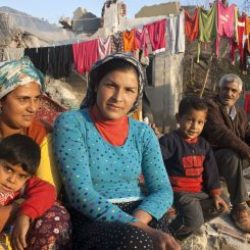
Sulukule: the first gypsy neighborhood in Europe

Barcelona: La Perona (1985-1989)
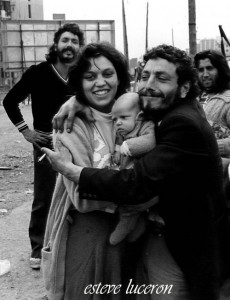 “Esteve Lucerón (Pobla de Segur, 1950), photographer, portrayed the gypsy settlement of La Perona for 10 years, from 1980 until its demolition. His photos are strongly influenced by the american reporters who worked on the Great Depression of 1929, Walker Evans, Dorothea Lange and Lewis Hine, especially in the relationship towards the people he portrayed: empathy, self control, he never manipulates his subjects to stress the drama, never breaks the intimacy, doesn’t steal poverty. He doesn’t either have a sweetened merciful attitude: there’s social critique, it’s an anthropological document, historically valuable, since these settlements belong to a time of economical prosperity in Spain, when real estate speculation and conflicts among “lineages” or subgroups of gypsies burst, as the City Council decided to relocate – transfer/deport – some groups from an area to another with no regard except for the number of people. Lucerón gives a personal view of it, with a special attention towards children, and towards gypsy’s typical sense of humor, naughty and defiant“. Froum María José Furio‘s review on her blog. Some photos: [1][2]
“Esteve Lucerón (Pobla de Segur, 1950), photographer, portrayed the gypsy settlement of La Perona for 10 years, from 1980 until its demolition. His photos are strongly influenced by the american reporters who worked on the Great Depression of 1929, Walker Evans, Dorothea Lange and Lewis Hine, especially in the relationship towards the people he portrayed: empathy, self control, he never manipulates his subjects to stress the drama, never breaks the intimacy, doesn’t steal poverty. He doesn’t either have a sweetened merciful attitude: there’s social critique, it’s an anthropological document, historically valuable, since these settlements belong to a time of economical prosperity in Spain, when real estate speculation and conflicts among “lineages” or subgroups of gypsies burst, as the City Council decided to relocate – transfer/deport – some groups from an area to another with no regard except for the number of people. Lucerón gives a personal view of it, with a special attention towards children, and towards gypsy’s typical sense of humor, naughty and defiant“. Froum María José Furio‘s review on her blog. Some photos: [1][2]
- Esteve Lucerón. La Perona (1985-1989). Agenda de la Imatge n. 56 (2010). Xavier Camino and Pili Díaz Giner wrote the text, and Jordi Gratacós, secretary of UPIFC, made the laboratory work on the photo negatives. [Exposition announced in UPIFC webpage]

The dreams of architecture
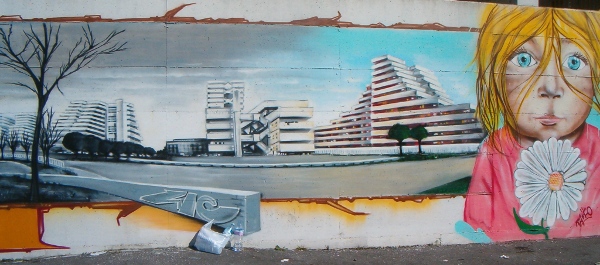 "Secondigliano, Miano, Piscinola, all the northern periphery, and most of all Scampia, the youngest and most cursed neighborhood of Napols, have been covered with negative symbols, emblems of something dark and persistent, that by extension stains all the tens of thousands people that, in the peripheries, keep living a normal life". (Rossomando, 2007). For Scampia's "Le Vele", the enormous buildings erected in the 70s as a progressive and modernist project, and that now have become an internationally renown scenario of crime and marginality, the City Council is looking again for an architectural solution: to demolish or to preserve? The utopia is the "tabula rasa", i.e. solving social problems by tearing down and start again, or emptying and convert into a monument. "The complexity of places is poorly reduced to the choice between demolition and capitalization, both easy and spectacular solutions based on an attack on inhabitants' history" (Nocera 2010). Different are the utopias that follow all the people who struggle every day supporting the gypsies of Scampia's Rom community, the inhabitants of "Le Vele", the families suffering the consequences of so many years of corruption and crime. Will all this also end up into a "tabula rasa"?
"Secondigliano, Miano, Piscinola, all the northern periphery, and most of all Scampia, the youngest and most cursed neighborhood of Napols, have been covered with negative symbols, emblems of something dark and persistent, that by extension stains all the tens of thousands people that, in the peripheries, keep living a normal life". (Rossomando, 2007). For Scampia's "Le Vele", the enormous buildings erected in the 70s as a progressive and modernist project, and that now have become an internationally renown scenario of crime and marginality, the City Council is looking again for an architectural solution: to demolish or to preserve? The utopia is the "tabula rasa", i.e. solving social problems by tearing down and start again, or emptying and convert into a monument. "The complexity of places is poorly reduced to the choice between demolition and capitalization, both easy and spectacular solutions based on an attack on inhabitants' history" (Nocera 2010). Different are the utopias that follow all the people who struggle every day supporting the gypsies of Scampia's Rom community, the inhabitants of "Le Vele", the families suffering the consequences of so many years of corruption and crime. Will all this also end up into a "tabula rasa"? 
The slums of Poblenou
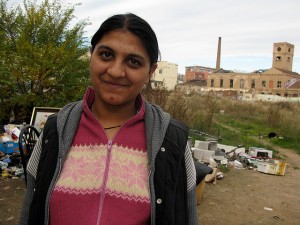 "The last gypgy settlement in Poblenou has been evicted" as was announced in Barcelona's newspapers on october 6th, 2010. But if we read better, the real news are that there had been no eviction: too many children were living in the settlement. When newspapers deal with the item of gypsy settlements in Poblenou, industrial neighborhood of Barcelona undergoing a big urban renewal process, they always approach it as if this settlements are about to disappear, like if they were pintoresque remainders of a past now gone f According to the press, "the last settlements in Poblenou" had already been evicted in 2004 in carrer Agricultura, or in the Oliva Artés factory in 2003. When they speak of gypsy settlements, they always use the word "barraques" (slums), a particulary thick term: the struggle against Barcelona's slums was one of the victories of grassroots movements in the 60s and 70s. So, these news about the gypsies and their shanty towns so close to the skyscrapers of the new "technological district 22@", more than a revival of the "barraquismo" as a phenomenon, they make us think of a revival of the uses of this phenomenon: an instrument that serves the purpose of giving an excuse to simplify the conflicts and contradictions that go along with this enormous urban renewal project. If the gypsies and their slums belong to the past, and the skyscrapers to the future, every eviction can appear as a debt with history. Social policies, are the real remainder of a past now gone.
"The last gypgy settlement in Poblenou has been evicted" as was announced in Barcelona's newspapers on october 6th, 2010. But if we read better, the real news are that there had been no eviction: too many children were living in the settlement. When newspapers deal with the item of gypsy settlements in Poblenou, industrial neighborhood of Barcelona undergoing a big urban renewal process, they always approach it as if this settlements are about to disappear, like if they were pintoresque remainders of a past now gone f According to the press, "the last settlements in Poblenou" had already been evicted in 2004 in carrer Agricultura, or in the Oliva Artés factory in 2003. When they speak of gypsy settlements, they always use the word "barraques" (slums), a particulary thick term: the struggle against Barcelona's slums was one of the victories of grassroots movements in the 60s and 70s. So, these news about the gypsies and their shanty towns so close to the skyscrapers of the new "technological district 22@", more than a revival of the "barraquismo" as a phenomenon, they make us think of a revival of the uses of this phenomenon: an instrument that serves the purpose of giving an excuse to simplify the conflicts and contradictions that go along with this enormous urban renewal project. If the gypsies and their slums belong to the past, and the skyscrapers to the future, every eviction can appear as a debt with history. Social policies, are the real remainder of a past now gone.
- "Paisatges urbans - paisatges humans" - Photo reportage on Poblenou, by Núria Sánchez Armengol (2008)
- Webpage of "Barraques - la ciutat informal" exposition, Museum of City History [LINK]
- News on the eviction of 6/10/2010 [VIDEO]
- Urban nomadism in Poblenou, 2000-2005: draft of a research, in Poblenou avui, part2 [PDF]
- april 2012: four people died for an accidental fire in a shack in Can Ricart, among them possibly one of the women portrayed in these photos.
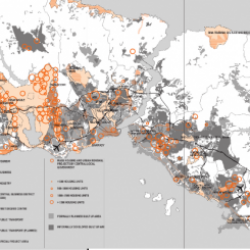
Istanbul: living in voluntary and involuntary exclusion
